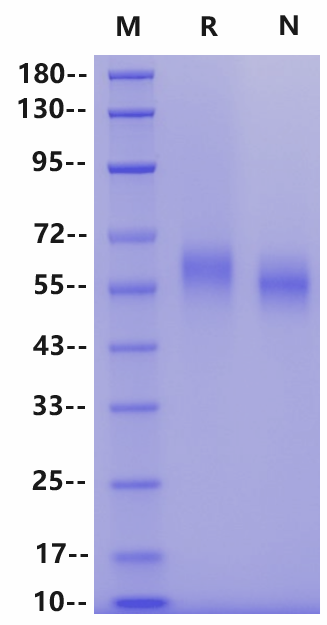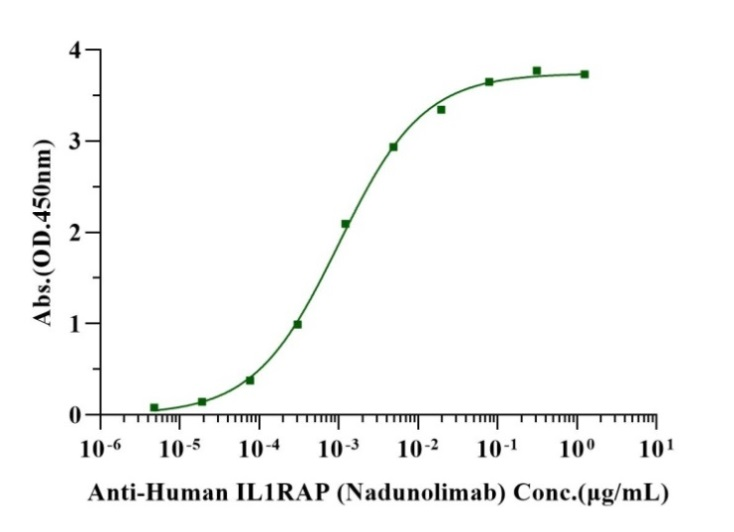Ser21-Glu359, with C-terminal 10*His SERCDDWGLDTMRQIQVFEDEPARIKCPLFEHFLKFNYSTAHSAGLTLIWYWTRQDRDLEEPINFRLPENRISKEKDVLWFRPTLLNDTGNYTCMLRNTTYCSKVAFPLEVVQKDSCFNSPMKLPVHKLYIEYGIQRITCPNVDGYFPSSVKPTITWYMGCYKIQNFNNVIPEGMNLSFLIALISNNGNYTCVVTYPENGRTFHLTRTLTVKVVGSPKNAVPPVIHSPNDHVVYEKEPGEELLIPCTVYFSFLMDSRNEVWWTIDGKKPDDITIDVTINESISHSRTEDETRTQILSIKKVTSEDLKRSYVCHARSAKGEVAKAAKVKQKVPAPRYTVEGGGSGGGSHHHHHHHHHH
55-70kDa
>95% by SDS-PAGE
Reconstitute at 0.1-1 mg/ml according to the size in ultrapure water after rapid centrifugation.
1、Goldbach-Mansky R. et al. (2009) Autoinflammation: the prominent role of IL-1 in monogenic autoinflammatory diseases and implications for common illnesses. J Allergy Clin Immunol. 124(6): 1141-1149.
2、Johnston A. et al. (2011) IL-1F5, -F6, -F8, and -F9: a novel IL-1 family signaling system that is active in psoriasis and promotes keratinocyte antimicrobial peptide expression. J Immunol. 186(4): 2613-2622.
3、Ozaki K. et al. (2001) Effect of tumor weight and tube feeding on TNF-alpha and IL-1beta mRNA expression in the brain of mice. JPEN J Parenter Enteral Nutr. 25(6): 317-322.
Interleukin-1 receptor accessory protein (IL1RAP or IL-1RAcP) is also known as Interleukin-1 receptor 3 (IL-1R-3 or IL-1R3), C3orf13, which belongs to the interleukin-1 receptor family. It serves as a non-ligand-binding component of the receptors for IL-1 alpha, IL-1 beta, IL-33, and IL-36. Mature human IL-1 RAcP consists of a 347 amino acid (aa) extracellular domain (ECD) with three Ig-like domains, a 21 aa transmembrane segment, and a 182 aa cytoplasmic domain. Coreceptor with IL1R1 in the IL-1 signaling system. Associates with IL1R1 bound to IL1B to form the high affinity interleukin-1 receptor complex which mediates interleukin-1-dependent activation of NF-kappa-B and other pathways. Signaling involves the recruitment of adapter molecules such as TOLLIP, MYD88, and IRAK1 or IRAK2 via the respective TIR domains of the receptor/coreceptor subunits. Does not bind to interleukin-1 alone; binding of IL1RN to IL1R1, prevents its association with IL1R1 to form a signaling complex. The cellular response is modulated through a non-signaling association with the membrane IL1R2 decoy receptor. Coreceptor for IL1RL1 in the IL-33 signaling system. Can bidirectionally induce pre- and postsynaptic differentiation of neurons by trans-synaptically binding to PTPRD.


Immobilized IL-1RAcP/IL-1R3 His Tag Protein, Human (Cat. No. UA010315) at 2.0μg/mL (100μL/well) can bind Anti-Human IL1RAP (Nadunolimab) with EC50 of 0.83-1.20 ng/ mL.